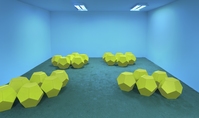2009 C. P. Snow Event: A Day of Science and Art with Spencer Finch
03/28/09
Contributed by Craig Duncan
 Internationally acclaimed modern artist Spencer Finch will explore how science and art are intertwined and can inform each other in a free public lecture at Ithaca College on Thursday, April 2. His talk, “Beauty and the Scientific Method,” is scheduled for 7:00 p.m. in Textor 102.
Internationally acclaimed modern artist Spencer Finch will explore how science and art are intertwined and can inform each other in a free public lecture at Ithaca College on Thursday, April 2. His talk, “Beauty and the Scientific Method,” is scheduled for 7:00 p.m. in Textor 102.
An installation of Finch’s works that bring together principles of science and art, created in collaboration with IC students, will also be on display throughout the day in the Center for Natural Sciences.
Spencer Finch's Official Site
Finch’s appearance is part of the C. P. Snow Lecture Series, named after the late physicist and novelist Sir Charles Percy Snow, who was awarded an honorary degree from Ithaca College in 1967. Snow described the intellectual scene of his time as follows: “Literary intellectuals at one pole -- at the other scientists ... Between the two a gulf of mutual incomprehension.” The School of Humanities and Sciences established the lecture series in 1964 in an attempt to help bridge that gulf.
Also, each year the School awards the C. P. Snow Scholar Award, which recognizes an Ithaca College student whose college career has bridged the humanities and sciences in an exemplary way. This year's C. P. Snow Scholar Award will be announced on April 2 at the start of Finch's talk.
C. P. Snow Lecture Series
Science and scientists have been inspirations for Finch’s own practice as an artist. His wide-ranging talk will examine the way that the scientific method and strategies of art-making are analogous, incorporating examples drawn from 19th-century science and technology such as the telegraph, artists such as Monet and Seurat, and his own contemporary artwork. His presentation will include a dramatic recreation of Galileo’s refutation of Aristotle’s theory of falling bodies -- using grapefruit and duct tape.
Finch holds a bachelor of arts degree in comparative literature from Hamilton College and an M.F.A in sculpture from the Rhode Island School of Design. His work bridges the gap between the humanities and sciences by questioning our ability to observe and comprehend our natural world and by exploring what is “real” about what we see. “There is always a paradox inherent in vision; an impossible desire to see yourself seeing,” says Finch. “A lot of my work probes this tension: to want to see, but not being able to.”
His exhibits have included “What Time Is It On The Sun?” at MASS MoCA in North Adams, Massachusetts; “As If the Sea Should Part and Show a Further Sea” at Queensland Art Gallery in Brisbane, Australia; and the public art project “The River That Flows Both Ways,” along a historic elevated railway on Manhattan’s west side.
MASS MoCA: "What Time Is It on the Sun?"
Press Release: "The River That Flows Both Ways" (.pdf)
In conjunction with Finch’s visit, the Center for Natural Sciences (CNS) will host "A Day of Science and Art" and be transformed into a gallery on April 2. In addition to four installations of his work, art created by Ithaca College students on the themes of micro/macro, light, and the color wheel will also be on display, as will scientific images provided by Ithaca College faculty.
These installations -- some of which include interactive viewer participation that will literally mix science and art -- will be open for viewing from 10:00 a.m. to 6:00 p.m. A formal reception featuring Finch is scheduled for 4:00 p.m. on the second floor of CNS.
For more information on Finch’s visit, contact Peter Melcher, associate professor of biology, at pmelcher@ithaca.edu or 607- 274-3980.
Photo: Spencer Finch's "Bee Pollen" installation allows visitors to see "pollen" in the exact shade of color in which bees view it.
0 Comments
https://www.ithaca.edu/intercom/article.php/20090327085704386
 Internationally acclaimed modern artist Spencer Finch will explore how science and art are intertwined and can inform each other in a free public lecture at Ithaca College on Thursday, April 2. His talk, “Beauty and the Scientific Method,” is scheduled for 7:00 p.m. in Textor 102.
Internationally acclaimed modern artist Spencer Finch will explore how science and art are intertwined and can inform each other in a free public lecture at Ithaca College on Thursday, April 2. His talk, “Beauty and the Scientific Method,” is scheduled for 7:00 p.m. in Textor 102.